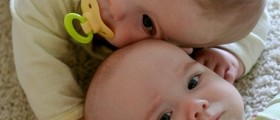
1. Men returning from combat are more likely to father twins. After both the first and second world wars, men returning from battle were far more likely to father twins than men who did not. Although this phenomenon is known in the scientific literature as the "returning soldier syndrome," it could just as easily be called the "faithful wife syndrome." There is something about prolonged absence from sexual relations that is related to having twins and triplets.
2. Women who take more folic acid the week they conceive are more likely to have twins. Scientists at the Murdoch Childrens' Research Institute in Melbourne, Australia, have noticed this tendency in their reviews of six studies of folic acid supplementation for women, folic acid added to foods to prevent birth defects such as cleft palate and spina bifida. The women who consumed the highest levels of folic acid the week they conceived were 26% more likely to conceive fraternal twins but 24% less likely to conceive identical twins.
3. Eating well and avoiding stress are associated with increased rates of twin births. In the nineteenth century, Sweden was one of the poorest countries in Europe. In the twentieth century, Sweden was one of the richest countries in Europe. Scientists examining birth records going back to 1751 found that with prosperity, the rate of twin births increased 75 per cent.
4. Variations in technique in IVF (in vitro fertilization) make a big difference in rates of twins even when the procedure is performed by the best fertility doctors. When the blastocysts are transferred into the woman's uterus five days after fertilization, there is a much higher likelihood of having identical twins than if they are transferred on the third day after fertilization.
Fertility treatment with Clomid often results in multiple births. It is also commonsensical to suppose that repeated sexual intercourse during days 11 through 16 of a woman's menstrual period (if her period is 28 days long) would also result in greater likelihood of having twins. However, it is also useful to that the chemical environment of the cervix also has a lot to do with whether a sperm carrying an X chromosome (becoming a girl) or a sperm carrying a Y chromosome (becoming a boy) survives to reach the egg. Repeated sexual intercourse earlier in a woman's menstrual cycle (shortly before or at ovulation) is more likely to result in boys. Repeated sexual intercourse later in a woman's menstrual cycle (shortly after ovulation) is more likely to result in girls.
- www.betterhealth.vic.gov.au/health/ConditionsAndTreatments/twins-identical-and-fraternal
- www.nih.gov/news-events/news-releases/new-treatment-increases-pregnancy-rate-women-infertility-disorder
- Photo courtesy of Donnie Ray Jones via Flickr:https://www.flickr.com/photos/donnieray/9248400652
















Your thoughts on this
Loading...